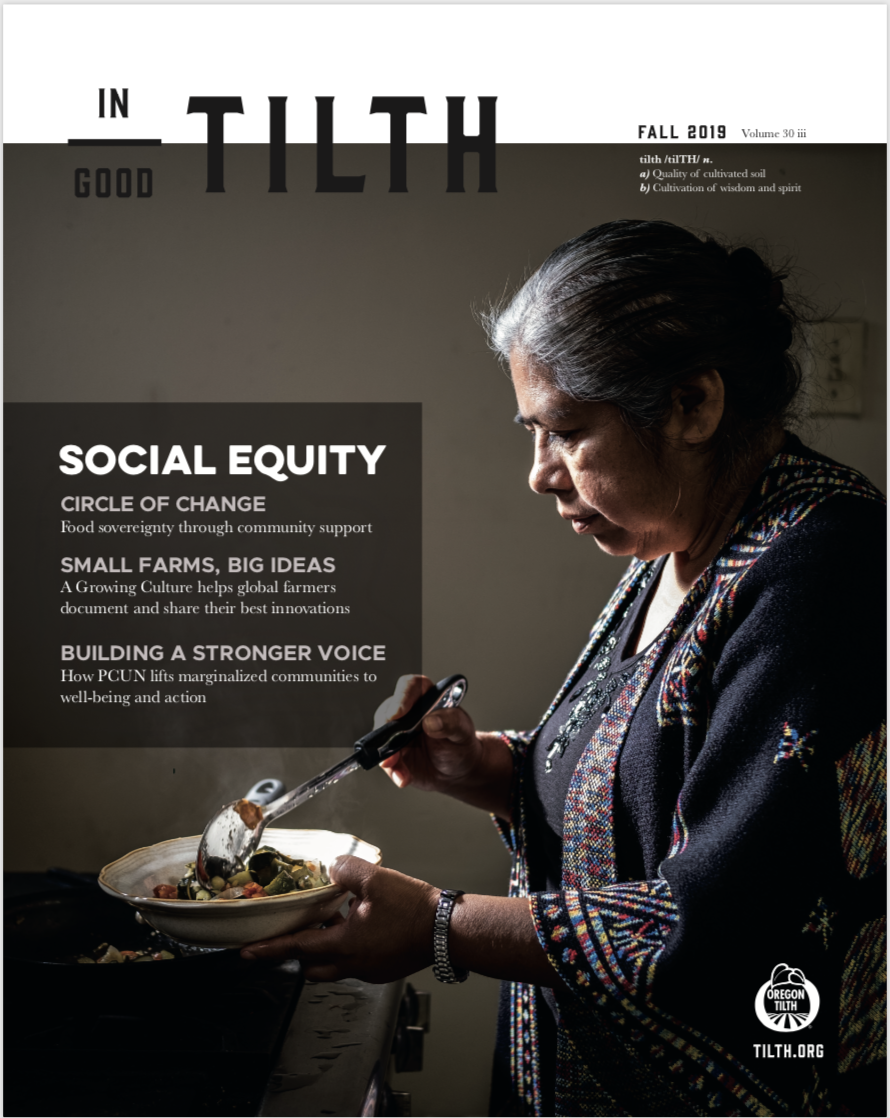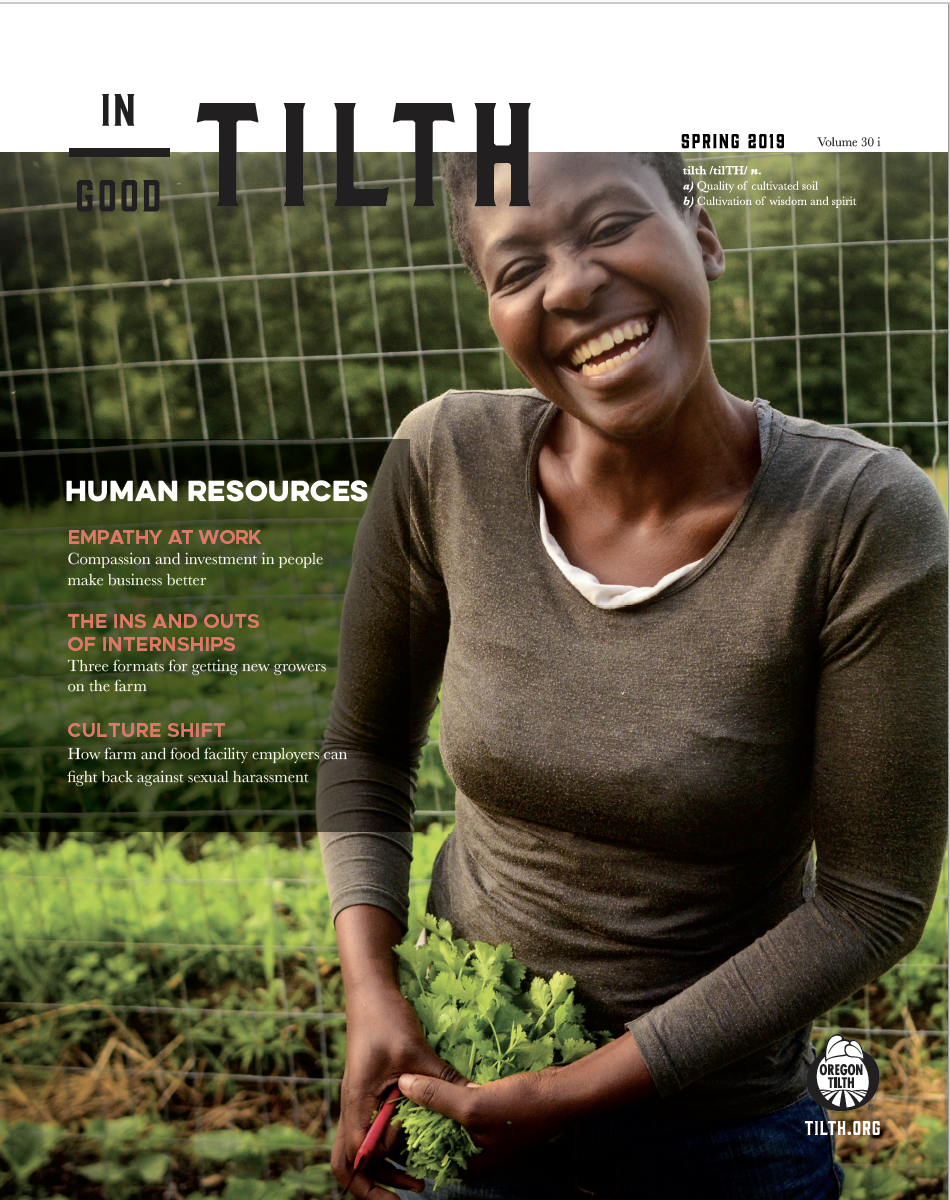Oregon’s organic farmers will benefit from new research, education and outreach thanks to a new OSU Organic Extension program, dedicated to building and sustaining organic agriculture — Oregon’s fastest-growing farm sector.
Oregon Tilth, a Corvallis-based nonprofit organic certifier and advocate for sustainable agriculture, has pledged $100,000 in matching funds over four years to support the program.
Oregon Tilth Executive Director Chris Schreiner said that this is an important first step. “We’ve created a part-time position to develop and lead an Organic Extension Program. This is built into a faculty position description, whose responsibilities were developed in close consultation with Oregon Tilth. It codifies organic as an important sector of Oregon agriculture that OSU will be better able to serve through a dedicated program.
“A multi-year investment commitment is an important signal to OSU administrators that the organic community values an Organic Extension Program. By joining as a founding partner, Oregon Tilth also sets a standard for other organic industry partners and can inspire similar contributions to help expand the scope and impact of an Organic Extension Program.”
Soon after Oregon Tilth announced its pledge, Vitalis Organic Seeds followed suit with a $7,500 pledge to support the program.
Creating connections
The program was launched in fall 2016, and currently consists of one part-time Organic Extension Agent with the hope of expanding the program in coming years.
Manning the position is Nick Andrews, a long time Small Farms Extension agent with OSU, focused on bringing his experiences with Oregon’s organic farmers to shape the program. To start, he will focus on overall program development and educational resources for annual organic crops. Several OSU Extension faculty with an interest in organic production systems have been supporting innovations in a variety of organic cropping systems, including vegetables, berries, small grains, dairy and tree fruit/nuts.
Recent accomplishments have relied on keen faculty interest and the availability of organic research funds. Establishment of dedicated funding for the Organic Extension program will enable dedicated faculty to identify needs and support innovation specifically for the organic agriculture sector.
Historical perspective
In 1862, the Morrill Act gave states public lands, provided the lands be sold or used for profit and the proceeds used to establish at least one college — a land-grant university (LGU) — that would teach agriculture and the mechanical arts.
The colleges acquired a research function in 1887 through the Hatch Act, which recognized the need for original research to underpin the teaching of agriculture and help develop agricultural innovation. With a long history of supporting agriculture in their state via research, education and extension, LGUs and their faculty have developed strong reputations in agricultural communities as a credible source of independent information for farmers.
Any effort to support increased adoption of organic management practices will be greatly amplified if LGU faculty and resources are involved. If Extension agents are unaware of the benefits of — or prejudices against — organic production, then viable opportunities to expand and research biologically aligned agriculture may be lost, leaving chemically dependent production systems as the main model of agriculture unchallenged.
OSU’s organic research and extension projects will initially focus on annual crops, but the scope of the program will increase to include perennial crops, livestock systems, local food systems and other topics as more organic extension agents come on board. Agents promoting organic practices while supporting farmers — organic and conventional — in search of solutions or education, will be a radical boost happening at a critical stage of interaction with farm practitioners.
Garry Stephenson, director of the OSU Center for Small Farms and Community Food Systems, said, “We envision an Organic Extension Program with four or more positions around Oregon, focused on different crop and livestock systems as well as local food system development.” These positions will be field-based faculty with statewide appointments.

Crafting extension education around decision-making tools
Achieving sustainable agricultural development is less based on material inputs (e.g., seeds and fertilizer) than on the very people involved in their use. This calls for increased knowledge and information sharing about agricultural production, as well as on appropriate delivery approaches, channels and tools. When new agricultural technologies are generated by research institutions or farmers, agricultural extension services are well positioned to help disseminate these tools amongst their practitioner community networks.
Nick Andrews’ experiences in the field and collaboration with OSU Extension specialists has led to the development of innovative tools for organic producers, such as the OSU Organic Fertilizer and Cover Crop Calculator — a tool developed with funding from Western Sustainable Agriculture and Education Program (WSARE) and Oregon Tilth that helps farmers estimate nitrogen release from cover crops to help calculate organic fertilizer rates more accurately.
Croptime, a web-based tool also developed with support from WSARE and Oregon Tilth, uses degree-day models to estimate time to maturity for vegetable varieties using temperature and time. These models can be more accurate than crop maturity information found in seed catalogs. Croptime also predicts germinable seed times for three important weed species. Andrews noted, “Right now we have 11 crop models and three weed models online. We are working on models for an additional 40 vegetable varieties. Factors other than temperature can affect the growth and development rate of vegetables; degree-day models can predict shorter time-to-harvest depending on a crop’s planting date. That’s going to be more accurate.”
The Organic Extension program’s ability to develop more decision tools like the Cover Crop Calculator and Croptime will give farmers ready-to-use instruments that can improve farm and business management practices.

Extension is equal parts business and farm production managment
While Andrews’ work focuses on tools and best practices in the field, many organic growers simply need to better understand and calculate their bottom line.
The Organic Extension Program will incorporate much of the work from OSU’s Center for Small Farms and Community Food Systems to create viability and diversity in its education programs. Oregon Tilth’s longstanding partnership with the Center has recently placed focus on cultivating farm business strategies and tools.
Tanya Murray, Oregon Tilth’s Organic Education Specialist, has been developing economic tools for organic farmers to support high-quality food production while turning a profit. The joint project aims to simplify in-season organic recordkeeping by using a time-study approach to track labor costs. Murray explains, “Upon completion of the cost-study program, farmers will have information about which profitable crops might be scaled up, and the less profitable ones may warrant a closer look.”
eOrganic at OSU and beyond
Very few LGUs have anything even close to OSU’s planned Organic Extension Program. For them, eOrganic, hosted by OSU, helps fill in the gaps. An online knowledge-sharing network, eOrganic leverages the ease of access of a web-based resource with the power of expert practitioners answering farmers’ questions on organic practices.
OSU’s Alice Formiga, Webinar and Evaluation Coordinator for eOrganic, clarifies that “eOrganic is the organic agriculture community part of eXtension.org — a national online extension initiative. In addition to webinars and sometimes broadcasting and recording presentations from organic conferences, we also publish articles, videos and answer Ask an Expert questions.”
Since 2009, eOrganic has run over 150 webinars on a wide range of organic practices as well as findings from current organic research: how to get certified; how to take advantage of Natural Resources Conservation Service programs; how to produce seeds organically; research on no-till and cover crops; managing organic dairy herd health; managing pests organically; food safety; and biodiversity, just to name a few.
Fabian Menalled of Montana State University (MSU) is eOrganic’s Community of Practice Leader; he is also developing a formal organic extension program for MSU. His work focuses on helping organic farmers with issues that arise in Montana’s “golden triangle” between Glacier and Yellowstone National Parks and eastern Idaho, where organic lentils are a signature crop. Working with eOrganic at OSU and the Montana Organic Association, a nonprofit supporting organic agriculture since 2002, Menalled tackles some of Big Sky Country’s thorniest issues on the ground, like the invasive Canada thistle and the pernicious field bindweed.
OSU’s hosting and involvement with eOrganic gives it access to a nationwide database of resources and keeps it firmly connected to the questions and issues that continue to plague organic producers. The online community is another resource for OSU’s extension program, creating links between organic growers to share knowledge as well as repurpose a wide range of videos and conversations from leading experts from around the country.
Extension extends impact throughout the supply chain
Jim Henderson, farmer liaison at Eugene’s Hummingbird Wholesale, sees persistent issues with garbanzos, red wheat and hazelnuts that could be addressed by an organic extension program. “We have this garbanzo bean blight [and some producers] lost the entire crop this year. One plant can ruin acres with the nightshade berries on it. It goes through the combine and gets the whole product screwed up.”
“We also struggle with maintaining our protein levels with our red wheat. I’ve seen the protein go from 11 to 15 in a year. Our requirement is 13 percent. If there’s not enough protein, I have to dump it on the feed market, if that market exists.” Oregon produces five percent of the hazelnut (filbert) world crop and 99 percent of the U.S. crop. Oregon hazelnuts have become the global benchmark for in-shell excellence and are recognized for their large size and distinctive flavor.
Henderson observed, “There are several other guys who want to put in organic filbert orchards, and there’s a lot of questions out there, like which varieties are more blight resistant than others, what kind of pheromone traps and when do you put them out to control the filbert worm?” The strategic position of an organic extension program will create a central place for growers to flock to with questions on staple or high-value crops.
Influencing the farm community
Certainly, there are plenty of issues to keep Andrews and future Organic Extension colleagues busy in Oregon. But when I spoke with him, he was at San Francisco Airport, on his way to Bhutan, as part of a delegation to assist the country to go fully organic.
“Garry Stephenson and I have been working with them on a curriculum for their graduate degree in organic agriculture. Then we are going to meet with the national organic program coordinator, and organic farmers. Hopefully, we’ll be able to set up exchanges between farmers and ag professionals over time. Bhutan is a tiny country, with very traditional Buddhist practices. Organic farming is very consistent with their religion and values, so they’re adopting it.”
Can our own multi-faceted farming and LGU culture in the United States get behind organic with such focus? Oregon Tilth and OSU think so, and are quietly working together behind the scenes to change the culture of our agriculture and beyond.



















